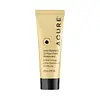What's inside
What's inside
 Key Ingredients
Key Ingredients

 Benefits
Benefits

 Concerns
Concerns

 Ingredients Side-by-side
Ingredients Side-by-side

Water
Skin ConditioningCetearyl Alcohol
EmollientCarthamus Tinctorius Seed Oil
MaskingGlyceryl Stearate Citrate
EmollientCocoglycerides
EmollientAloe Barbadensis Leaf Juice
Skin ConditioningHelianthus Annuus Seed Oil
EmollientGlyceryl Laurate
EmollientTheobroma Cacao Seed Butter
EmollientGlycerin
HumectantSqualane
EmollientTocopherol
AntioxidantTocopheryl Acetate
AntioxidantWithania Somnifera Root Extract
Skin ConditioningOcimum Sanctum Leaf Extract
Skin ConditioningGanoderma Lucidum Extract
Skin ProtectingCordyceps Sinensis Extract
AntioxidantCurcuma Longa Root Extract
MaskingSpinacia Oleracea Leaf Extract
Skin ConditioningBrassica Oleracea Acephala Leaf Extract
HumectantArthrospira Platensis Extract
AntioxidantOenothera Biennis Oil
EmollientArgania Spinosa Kernel Oil
EmollientChamomilla Recutita Flower Extract
MaskingCalendula Officinalis Flower Extract
MaskingXanthan Gum
EmulsifyingSodium Levulinate
Skin ConditioningGlyceryl Caprylate
EmollientPropanediol
SolventSodium Phytate
Potassium Sorbate
PreservativeSodium Anisate
AntimicrobialCitric Acid
BufferingWater, Cetearyl Alcohol, Carthamus Tinctorius Seed Oil, Glyceryl Stearate Citrate, Cocoglycerides, Aloe Barbadensis Leaf Juice, Helianthus Annuus Seed Oil, Glyceryl Laurate, Theobroma Cacao Seed Butter, Glycerin, Squalane, Tocopherol, Tocopheryl Acetate, Withania Somnifera Root Extract, Ocimum Sanctum Leaf Extract, Ganoderma Lucidum Extract, Cordyceps Sinensis Extract, Curcuma Longa Root Extract, Spinacia Oleracea Leaf Extract, Brassica Oleracea Acephala Leaf Extract, Arthrospira Platensis Extract, Oenothera Biennis Oil, Argania Spinosa Kernel Oil, Chamomilla Recutita Flower Extract, Calendula Officinalis Flower Extract, Xanthan Gum, Sodium Levulinate, Glyceryl Caprylate, Propanediol, Sodium Phytate, Potassium Sorbate, Sodium Anisate, Citric Acid
Water
Skin ConditioningEthylhexyl Palmitate
EmollientCaprylic/Capric Triglyceride
MaskingGlycerin
HumectantSorbitan Stearate
EmulsifyingSodium Polyacrylate
AbsorbentPentaerythrityl Distearate
EmulsifyingPhenoxyethanol
PreservativeSodium Stearoyl Glutamate
CleansingBenzoic Acid
MaskingCarbomer
Emulsion StabilisingDehydroacetic Acid
PreservativeEthylhexylglycerin
Skin ConditioningEpilobium Angustifolium Flower/Leaf/Stem Extract
Skin ConditioningCitric Acid
BufferingSodium Metabisulfite
AntioxidantSodium Hydroxide
BufferingWater, Ethylhexyl Palmitate, Caprylic/Capric Triglyceride, Glycerin, Sorbitan Stearate, Sodium Polyacrylate, Pentaerythrityl Distearate, Phenoxyethanol, Sodium Stearoyl Glutamate, Benzoic Acid, Carbomer, Dehydroacetic Acid, Ethylhexylglycerin, Epilobium Angustifolium Flower/Leaf/Stem Extract, Citric Acid, Sodium Metabisulfite, Sodium Hydroxide
Ingredients Explained
These ingredients are found in both products.
Ingredients higher up in an ingredient list are typically present in a larger amount.
Citric Acid is an alpha hydroxy acid (AHA) naturally found in citrus fruits like oranges, lemons, and limes.
Like other AHAs, citric acid can exfoliate skin by breaking down the bonds that hold dead skin cells together. This helps reveal smoother and brighter skin underneath.
However, this exfoliating effect only happens at high concentrations (20%) which can be hard to find in cosmetic products.
Due to this, citric acid is usually included in small amounts as a pH adjuster. This helps keep products slightly more acidic and compatible with skin's natural pH.
In skincare formulas, citric acid can:
While it can provide some skin benefits, research shows lactic acid and glycolic acid are generally more effective and less irritating exfoliants.
Most citric acid used in skincare today is made by fermenting sugars (usually from molasses). This synthetic version is identical to the natural citrus form but easier to stabilize and use in formulations.
Read more about some other popular AHA's here:
Learn more about Citric AcidGlycerin is already naturally found in your skin. It helps moisturize and protect your skin.
A study from 2016 found glycerin to be more effective as a humectant than AHAs and hyaluronic acid.
As a humectant, it helps the skin stay hydrated by pulling moisture to your skin. The low molecular weight of glycerin allows it to pull moisture into the deeper layers of your skin.
Hydrated skin improves your skin barrier; Your skin barrier helps protect against irritants and bacteria.
Glycerin has also been found to have antimicrobial and antiviral properties. Due to these properties, glycerin is often used in wound and burn treatments.
In cosmetics, glycerin is usually derived from plants such as soybean or palm. However, it can also be sourced from animals, such as tallow or animal fat.
This ingredient is organic, colorless, odorless, and non-toxic.
Glycerin is the name for this ingredient in American English. British English uses Glycerol/Glycerine.
Learn more about GlycerinWater. It's the most common cosmetic ingredient of all. You'll usually see it at the top of ingredient lists, meaning that it makes up the largest part of the product.
So why is it so popular? Water most often acts as a solvent - this means that it helps dissolve other ingredients into the formulation.
You'll also recognize water as that liquid we all need to stay alive. If you see this, drink a glass of water. Stay hydrated!
Learn more about Water